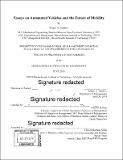Essays on automated vehicles and the future of mobility
Author(s)
Naumov, Sergey A.
Download1132264664-MIT.pdf (13.00Mb)
Alternative title
Essays on AVs and the future of mobility
Other Contributors
Sloan School of Management.
Advisor
Charles H. Fine.
Terms of use
Metadata
Show full item recordAbstract
Automated vehicle (AV) and electric vehicle (EV) technologies are expected to substantially reduce the negative externalities of driving. Combined with ubiquitous ride-hailing platforms that facilitate ride-sharing (pooling), AVs promise to make automobile transportation faster, safer, cheaper, more convenient, and environmentally friendly. Yet the endogenous impacts of AVs on demand for driving are not well understood. My first paper explores the effect of AVs and pooling on the performance of both roads and public transit in a bimodal transportation system. I develop a dynamic model that describes how commuters choose between driving a car or riding public transit in response to the changing attractiveness of these modes in the presence of AVs and pooling. I show that the well-intentioned move to promote pooling may have the unintended consequences of leading to both worse public transit quality and more rather than less traffic congestion if the public transit downward spiral is triggered. In my second paper, I use conjoint analysis to estimate consumer preferences for the attributes of ride-hailing services. I show that because consumers have an inherent aversion to pooling, and prefer cheaper trips, consumer choice of pooling is likely to drop in the future if the cost of driving falls with the introduction of AVs as some predict. In my third paper, I study the role of the accelerated vehicle retirement programs ('cash-for-clunkers') in reducing transportation fleet emissions. I use a model of vehicle fleet turnover in the United States to show that achieving climate goals will likely require 'cash-for-clunkers' policies that incentivize the accelerated retirement of older, less-efficient vehicles to be replaced by electric vehicles, combined with a rapid transition to renewable electricity. I demonstrate that such policies can be an effective way to make the vehicle fleet less emission-intensive, but that the costs could be high. I show that combining 'cash-for-clunkers' with a gas tax or carbon price would help offset the costs incurred while also reducing driving demand, helping to achieve a low-emissions transition in time.
Description
Thesis: Ph. D., Massachusetts Institute of Technology, Sloan School of Management, 2019 Cataloged from PDF version of thesis. Includes bibliographical references.
Date issued
2019Department
Sloan School of ManagementPublisher
Massachusetts Institute of Technology
Keywords
Sloan School of Management.